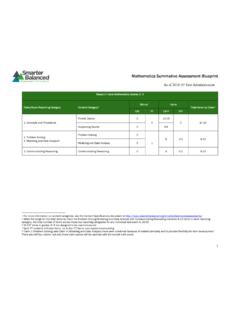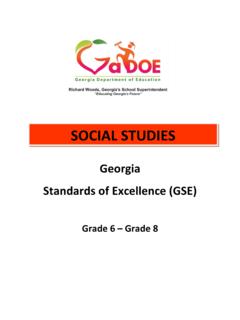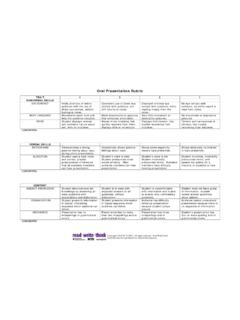Transcription of READING LITERARY (RL) READING INFORMATIONAL (RI)
1 9th-10th grade English Language Arts georgia standards of excellence (ELA GSE) georgia Department of Education April 15, 2015 Page 1 of 5 READING LITERARY (RL) READING INFORMATIONAL (RI) Key Ideas and Details Key Ideas and Details ELAGSE9-10RL1: Cite strong and thorough textual evidence to support analysis of what the text says explicitly as well as inferences drawn from the text. ELAGSE9-10RI1: Cite strong and thorough textual evidence to support analysis of what the text says explicitly as well as inferences drawn from the text.
2 ELAGSE9-10RL2: Determine a theme and/or central idea of text and analyze in detail its develo pment over the course of the text, including how it emer ges and is shaped and refined by specific details; provide an objective summary of the text. ELAGSE9-10RI2: Determine a central idea of a text and analyze its development over the course of the text, including how it emerges and is shaped and refined by specific details; provide an objective summary of the text. ELAGSE9-10RL3: Analyze how complex characters ( , those with multiple or conflicting motiv atio ns) develop over the course of a text, interact with other characters, and advance the plot or develop the theme.
3 ELAGSE9-10RI3: Analyze how the author unfolds an analysis or series of ideas or events, including the order in which the points are made, how they are introduced and develo ped, and the connections that are drawn between them. Craft and Structure Craft and Structure ELAGSE9-10RL4: Determine the meaning of words and phrases as they are used in the text, including figur ative and connotative meanings; analyze the cumula tive impact of specific wor d choices on meaning and tone ( , how the la nguage evokes a sense of time and place; how it sets a formal or informal tone.)
4 ELAGSE9-10RI4: Determine the meaning of words and phrases as they are used in a text, including figur ative, connotative, and technical meanings; analyze the cumula tive impact of specific wor d choices on meaning and tone ( , how the la nguage of a court opinion differs from that of a newspaper). ELAGSE9-10RL5: Analyze how an author s choices concerning how to structure a text, order events within it ( , parallel plots), and manipula te time ( , pacing, flashbacks) create such effects as mystery, tension, or surprise.
5 ELAGSE9-10RI5: Analyze in detail how an author s ideas or claims are developed and refined by particular sentences, paragraphs, or la rger portio ns of a text ( , a section or chapter). ELAGSE9-10RL6: Analyze a particular point of view or cultural experience reflected in a work of literature from outside the United States, drawing on a wide READING of world literature. ELAGSE9-10RI6: Determine an author s point of view or purpose in a text and analyze how an author uses rhetoric to advance that point of view or purpose.
6 Integration of Knowledge and Ideas Integration of Knowledge and Ideas ELAGSE9-10RL7: Analyze the representation of a subject or a key scene in two different artistic mediums ( , Auden s poem Mus e de Beaux Arts and Breughel s painting Landscape with the Fall of Icarus), including what is emphasized or absent in each treatment. ELAGSE9-10RI7: Analyze various accounts of a subject told in different mediums ( , a person s life stor y in pr int and multimedia), determining which details are emphasized in each account.
7 ELAGSE9-10RL8: (Not applicable to literature) ELAGSE9-10RI8: Delineate and evaluate the argument and specific claims in a text, assessing whether the reasoning is valid and the evidence is relevant and sufficient; identify false statements and fallacious reasoning. ELAGSE9-10RL9: Analyze how an author draws on and transforms source material in a specific wor k ( , how Shakespeare treats a theme or topic fro m Ovid or the Bible or how a la ter author draws on a play by Shakespeare). ELAGSE9-10RI9: Analyze seminal documents of historical and LITERARY significance ( , Washington s Farewell Address, the Gettysburg Address, Roosevelt s Four Freedoms speech, King s Letter from Birmingham Jail , Nelson Mandela s Nobel Peace Prize Speech, The Universal Declaration of Human Rights), including how they address related themes and concepts.
8 Range of READING and Level of Text Complexity Range of READING and Level of Text Complexity ELAGSE9-10RL10: By the end of grade 9, read and comprehend literature, including stories, dr amas, and poems, in the grades 9-10 text complexity band profic iently, with scaffolding as needed at the high end of the range. By the end of grade 10, read and compr ehend li teratur e, including stor ies, dr amas, and poems, in the grades 9-10 text complexity band pro fic iently, with scaffolding as needed at the high end of the range.
9 ELAGSE9-10RI10: By the end of grade 9, read and comprehend LITERARY nonfiction in the gr ades 9-10 text complexit y band pro fic iently, with scaffolding as needed at the high end of the range. By the end of grade 10, read and compr ehend li terary nonfiction in the grades 9-10 text complexity band independently and pro fic iently. 9th-10th grade English Language Arts georgia standards of excellence (ELA GSE) georgia Department of Education April 15, 2015 Page 2 of 5 Text Types and Purposes WRITING (W) ELAGSE9- 10W1: Write arguments to support clai ms in an anal ysis of substantive topics or texts, using valid reasoning and re levant and sufficient evidence.
10 A. Introduce precise clai m(s), distinguish the claim(s) from al ternate or opposing clai ms, and create an organization that establishes clear relat ionships among claim(s), counterc lai ms, reasons, and evidence. b. Develop clai m(s) and counterc laims fairly, supplying evidence for each while pointing out the strengths and limitations of both in a manner that anticipates the audience s knowledge level and concerns. c. Use words, phrases, and clauses to link the major sections of the text, create cohesion, and clarify the relationships between claim(s) and reasons, between reasons and evidence, and between claim(s) and counterc lai ms.

















